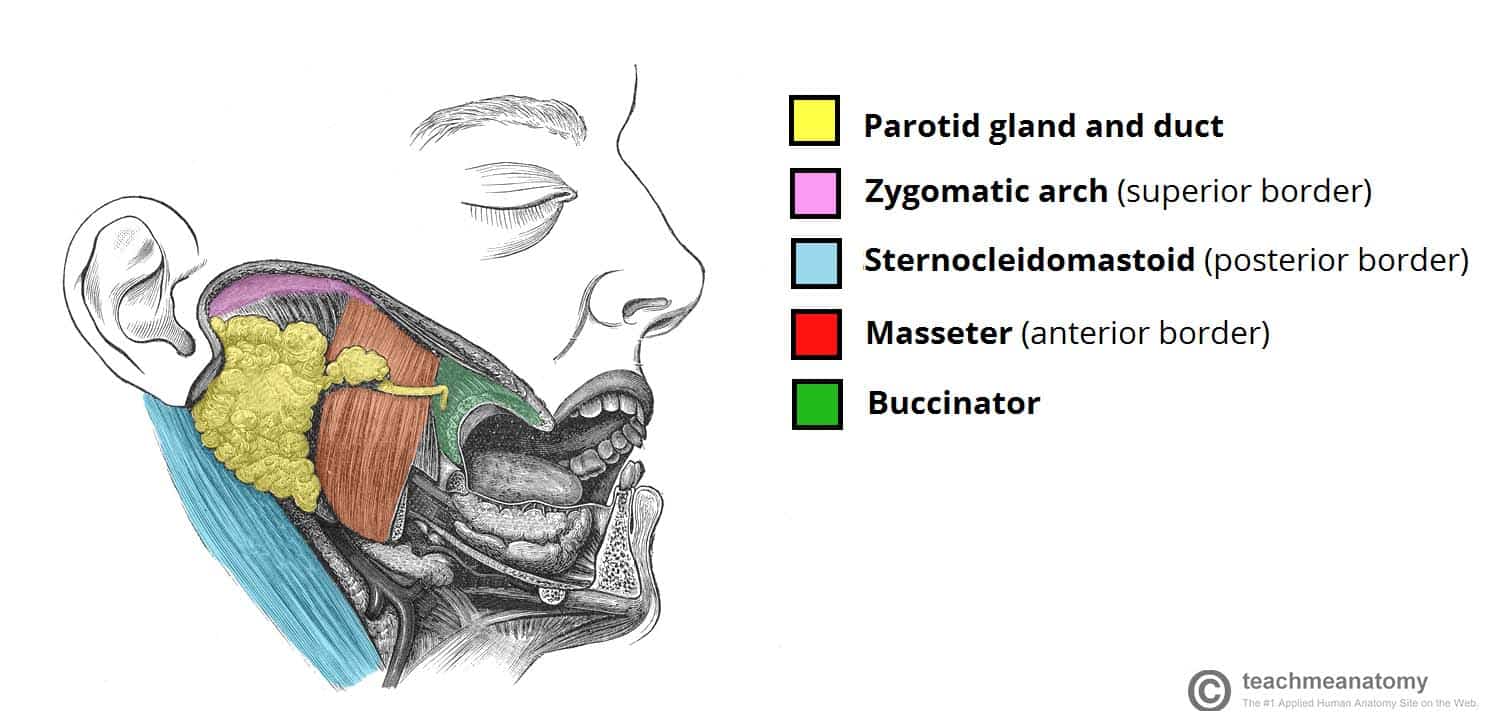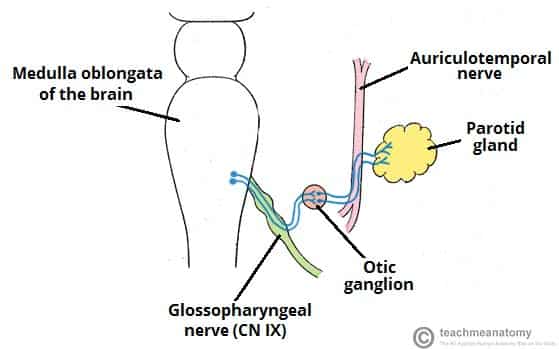Innervates Pharynx & Secretion of Parotid Salivary Gland
There are three main pairs of salivary glands. The saliva secreted keeps the mouth moist and facilitates mastication by lubricating the passage of the bolus.

The Parotid Gland Position Vasculature Innervation Teachmeanatomy
The gland is under parasympathetic regulation.

. Parasympathetic denervation of the major salivary glands leads to an immediate reduction of salivary secretion. The parotid glands are the largest of the three pairs of major salivary glands. GSA instead of GVA.
The parasympathetic innervation to the parotid gland has a complex path. Article in Polish Petela L. Conducts impulses for equilibrium and hearing Click to select 4.
When it comes to function salivary glands secrete saliva into the oral cavity. Functions Match the selected cranial nerves with their function. Innervates muscles of mastication Trigeminal nerve.
These glands are under the control of the autonomic nervous system comprised. Sensory innervation is supplied by the auriculotemporal nerve gland and the great auricular nerve fascia. Once in the glands the axons from each type of nerve intermingle and travel together in association with Schwann cells forming Schwann-axon bundles.
It begins with the glossopharyngeal nerve cranial nerve IX. Applied Anatomy Parotid Gland. The parasympathetic cell bodies that innervate the parotid gland are located in the otic ganglion.
At a rate of 05 ml min approximately 95 of saliva secreted by the parotid gland salivary watery and submandibular gland salivary mucin-rich. The two parotid glands are major salivary glands wrapped around the mandibular ramus in humans. The remainder is secreted by glands and.
It is the serous type of gland which secretes alpha-amylase also known as ptyalin. 5316532 PubMed - indexed for MEDLINE MeSH Terms. Innervates visceral smooth muscle and cardiac muscle.
Vision Click to select Innervates visceral smooth muscle and cardiac muscle Click to select Innervates pharynx secretion of parotid salivary gland Click to select Innervates muscles of mastication Click. The parasympathetic innervation to the parotid gland has a complex path. Saliva as you may know is a clear tasteless and odorless.
The parotid gland is innervated via the glossopharyngeal nerve CN IX. There are also a few smaller companions called accessory salivary glands which are sprinkled over the palate lips cheeks tonsils and tongue. Salivary glands are innervated by both sympathetic and parasympathetic nerve fibers.
Innervates the facial muscles Facial nerve. Click to see full answer. Match the selected cranial nerves with their function.
Innervates intrinsic and extrinsic tongue muscles. Innervates the facial muscles. Innervates intrinsic and extrinsic tongue muscles Hypoglossal nerve.
It is located in the retromandibular fossa space mainly occupied by this gland. It enters the oral cavity via the parotid duct. The secretion of saliva is controlled by a salivary center composed of nuclei in the medulla but there are specific triggers for this secretion.
The parotid glands are the usual site of infection with the virus that causes mumps paramyxovirus. It receives these fibers via the lesser petrosal nerve which is a branch of the glossopharyngeal nerve CN IX. Salivary spending about 05 to 15 liters per day.
The other major salivary glands are the submandibular glands and the sublingual glands. KW - Sympathetic innervation. Innervates pharynx secretion of parotid salivary gland Glossopharyngeal.
The oral cavity is drained by numerous salivary glands. Innervates muscles of mastication. The salivary glands are supplied by parasympathetic and sympathetic efferent nerves which travel to the glands by separate routes.
The autonomic innervation controls the rate of saliva production. When you eat it isnt just your teeth and jaw that help process your food. Salivary fluid secretion is largely dependent upon cholinergic signalling from parasympathetic nerves whilst the protein content of saliva is additionally.
Depending on the level of stimulation the flow rate varies from 01 to 4 ml min. It begins with the glossopharyngeal nerve cranial nerve IX. Innervates visceral smooth muscle and cardiac muscle Vagus nerve.
Stimulated saliva is reported to contribute as much as 80 to 90 of the average daily salivary production. Conducts impulses for equilibrium and hearing Vestibulocochlear nerve v Vision Click to select Innervates visceral smooth muscle and cardiac muscle Click to select ho Innervates pharynx secretion of parotid salivary gland Click to select Innervates muscles of mastication Click to select Innervates. Innervation of the parotid salivary gland in pigs and boar.
In the 1970s a number of studies showed that parasym- pathetic denervation of the major salivary glands leads to an immediate reduction of salivary secretion3 CLINICAL APPLICATIONS INFLUENCE OF DRUGS ON SALIVARY GLANDS All drugs acting on the autonomic nervous system influence the parotid gland to a greater or lesser extent. These are largest of the salivary glands secreting saliva to facilitate mastication and swallowing and amylase to begin the digestion of starches. The auriculotemporal nerve then carries parasympathetic fibres from the otic ganglion to the parotid gland.
Salivary glands are present in the cheek tongue lips oesophagus soft palate and pharynx but the major salivary glands are located further away from the oral cavity and function through connective. KW - Parotid gland. Mumps manifests by enlargement and inflammation of the parotid glands causing a characteristic swelling between the ears and the jaw.
Infections of the nasal passages and pharynx can attack any salivary gland. Saliva is produced and secreted by the salivary glands of the body. Because the secretory ducts lack sympathetic innervation the sympathetic nerves may not directly affect the ducts.
This nerve synapses with the otic ganglion a collection of neuronal cell bodies. Afferent signalling arises from taste olfaction and mastication and is modified by signalling from other centres in the central nervous system before efferent signals are delivered to salivary glands in autonomic nerves. Parasympathetic postganglionic cholinergic nerve fibers supply cells of both the secretory end-piece and ducts and stimulate the rate of salivary secretion inducing the formation of large amounts of a low-protein serous saliva.
Of note CN IX synapses on the otic ganglion. The parotid submandibular and sublingual glands. Salivary gland tumors are growths of abnormal cells tumors that begin in the salivary glands.
It also innervates two salivary glands and the lacrimal gland. So which cranial nerve innervates the parotid salivary gland. Preserving The Facial Nerve During Parotid Surgery.
The parasympathetic innervation to the parotid gland has a complex path. The parotid salivary gland is the largest salivary gland. Salivary secretion is nerve mediated.
Also Know which part of the nervous system controls Salivary Glands. Innervates pharynx secretion of parotid salivary gland. Parotid Glandinnervation Swineanatomy histology.
It is bordered superiorly by the zygomatic arch anteriorly by the masseter muscle and posteriorly by the sternocleidomastoid muscle. Sympathetic innervation may have a direct control on the glandular secretions of these two major salivary glands. Furthermore what nerve innervates the parotid gland.
The parotid gland is the largest of the three paired major salivary glands including the submandibular and sublingual glands. Saliva helps to breaks down the food you eat move it down the throat and protect you from infections. KW - Submandibular gland.
Postganglionic fibers from the otic ganglion then join the.

The Parotid Gland Position Vasculature Innervation Teachmeanatomy

The Parotid Salivary Glands Are Innervated By Branches Class 11 Biology Cbse

The Parotid Gland Position Vasculature Innervation Teachmeanatomy
Comments
Post a Comment